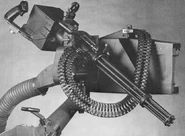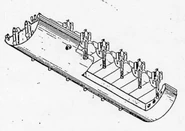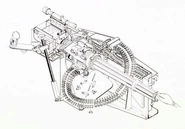The XM214 is a prototype 5.56mm rotary-barreled machine gun. It was designed and built by General Electric, but it never reached mass production. Also known as the Microgun, the weapon was a scaled-down version of the M134 Minigun, firing 5.56×45mm M193 ammunition.
Origins
The idea of a man-portable, multiple barrel firearm existed during WWII when the Neal submachine gun, a .22 LR calibre rapid-fire SMG capable of firing 3000 RPM developed for agile hit and run tactics. The Neal submachine gun was self operated using a blowback operation with a bolt that recoiled against a grooved drum rotating the barrel cluster, much similar to that of a Webley Fosbery automatic revolver.
Development
The XM214 was first developed for aircraft applications. Later General Electric developed it into a man-portable weapon system, known as the GE Six-Pak. The complete Six-Pak system weighed 85 pounds (38.5kg) with 1,000 rounds of ammunition, comparable in weight to some heavy machine guns. The basic gun in the Six-Pak weighed 27 pounds, or 12.2kg. The system could be carried by a team of two soldiers and mounted either to an M122 tripod or a vehicle's pintle mount. Length overall is 104.1cm, gun only is 68.6 cm long. Width (including ammunition case) is 44.4cm. Sighting was usually by optical telescope.
The Six-Pak consisted of the XM214, the ammunition package, the power module, and the ammunition module, which consisted of two 500-round, factory packed, and disposable cassettes mounted to a holding rack. Linked ammunition was fed through a flexible chute to the gun; when the first cassette was empty, ammunition would then feed from the second cassette, tripping a visible signal that a new cassette needed to be added to the rack.
The power module contained a 24 volt nickel-cadmium battery, an external motor, and solid state electronic controls. Unless the battery was plugged into a vehicle's power supply, the battery's charge would be depleted after 3,000 rounds. The system could be broken down quickly into two portable loads of roughly 42 pounds apiece. This was accomplished by means of a quick-release fitting at that end of the belt chute fastened to the gun.
Electronic controls contained a burst limiter and handled the automatic clearing of the gun after bursts. Using the electronic controls, the weapon's cyclic rate could be adjusted from 400 to 4,000 rounds per minute. Later editions of Jane's Infantry Weapons claimed a theoretical cyclic rate of up to 6,000 rounds per minute. George Chinn, author of The Machine Gun Volume V, contended that the XM214 prototype had a cyclic rate of up to 10,000 rounds per minute, but the man-portable Six-Pak was limited to 4,000 rounds per minute.
Microgun Pod
A 5.56mm Microgun Pod was also developed for external use on light aircraft and helicopters. The unit had an ammunition capacity of from 1,500 to 3,500 rounds and loaded weight of 186 to 300 pounds. The feed system was linkless, via a helical drum, with a nominal rate of fire of 6,000 rounds per minute. However, adjustments to 1,000 or 10,000 rounds per minute were possible, if desired. Power could be provided by a built-in battery pack, or from the aircraft itself.
Gallery
See also
- Self-operated
- Neal MG, a 5 barrel .22LR self operated weapon.
- XM133, a gas operated variant.
- EX-17 Heligun, a self operated rival to the M134.
- Bangerter machine gun, a 12 barrel self operated weapon.
- Slostin machine gun, a self operated weapon of Russian origin.
- Non-NATO
- Fokker-Leimberger, German equivalent to the M134.
- GShG-7.62, Russian equivalent to the M134.
- CS/LM12, Chinese equivalent to the M134.
- General





